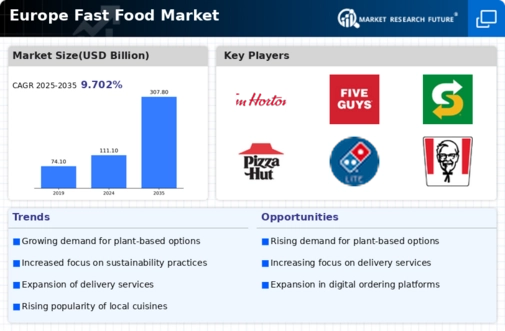The Europe Fast Food Market is characterized by intensely competitive dynamics, where various global and regional players vie for market share through innovative menu offerings, aggressive marketing strategies, and enhanced customer experiences. Consumers in Europe are increasingly inclined towards convenience, affordability, and a variety of food options, propelling fast food chains to continually evolve their services to meet these demands. The competition is not only among traditional fast-food giants but also newcomer brands focusing on niche products, health-conscious options, and local flavors.
The ongoing shifts in consumer preferences towards sustainable and ethically sourced ingredients have resulted in established brands reevaluating their supply chains and product offerings, while the growing trend of digital ordering and delivery services further shapes the competitive landscape. The influence of socioeconomic factors, food regulations, and cultural variations across European countries creates unique challenges and opportunities for companies seeking to penetrate or expand within this vibrant market.Tim Hortons has established a notable presence in the Europe Fast Food Market, leveraging its Canadian roots while adapting to local tastes.
The brand is recognized for its coffee and baked goods, appealing to a diverse customer base that values quick service and quality products. Its strengths lie in its ability to create a welcoming environment for coffee lovers, effective promotional strategies, and a focus on enhancing customer satisfaction. Tim Hortons has successfully localized its offerings, introducing menu items that resonate with European consumers, which aids in building brand loyalty.
Moreover, the brand's commitment to sustainability and community initiatives strengthens its position within the market, appealing to conscientious consumers who prioritize corporate social responsibility alongside taste and affordability.Five Guys has carved out a distinct niche in the Europe Fast Food Market, renowned particularly for its premium burgers and fresh-cut fries made from high-quality ingredients. The company prides itself on delivering a customizable burger experience, allowing customers to personalize their meals, which has become a key differentiator against traditional fast-food offerings.
Five Guys' commitment to freshness and quality enhances its brand appeal in Europe, where consumers are increasingly demanding transparency and higher quality in fast food. The company has expanded its footprint in various European countries, capitalizing on the growing popularity of gourmet fast food. Its strengths include robust customer engagement through its unique dining experience and strong word-of-mouth marketing. Although Five Guys has not emphasized mergers and acquisitions in Europe, its consistent focus on maintaining quality and customer service has allowed it to forge a strong presence and adaptive growth within the fast-evolving food landscape.























Leave a Comment